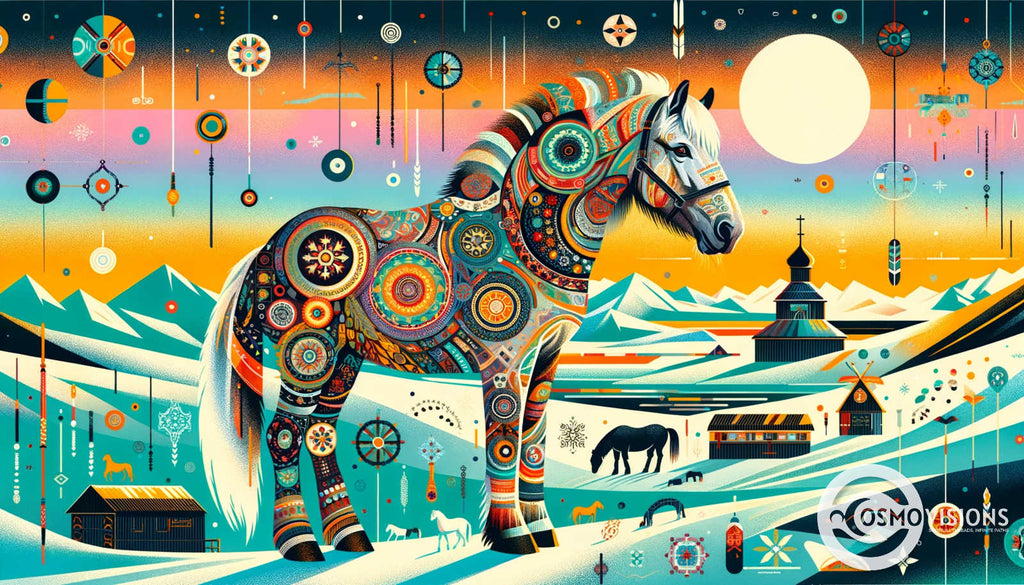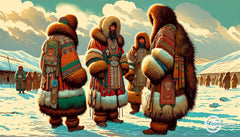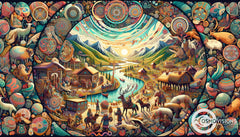Discover The Resilient And Hardy Yakut Horse: A Perfect Adaptation To Siberia's Challenging Conditions
Posted by Massimiliano Geraci

In the heart of Siberia's icy realm, where the cold bites with relentless fervor, survival is a testament to extraordinary resilience. For those enchanted by equine strength and grace under pressure, discovering how such creatures endure nature's extremes can ignite both curiosity and admiration.
The Yakut horse stands as a beacon of robustness in this unforgiving landscape—a spirited symbol of tenacity for people who cherish history, spirituality, and the artful connection between humans and horses.
One captivating fact about these four-legged marvels: they flourish where temperatures plummet to -70 degrees Fahrenheit! This blog will take you on an expedition through their evolutionary journey—exploring how Yakutian horses have not just survived but thrived in conditions that would freeze others in their tracks.
Your understanding will deepen; your respect will grow as we reveal what makes these incredible animals so unique. Ready? Let’s embark on this arctic adventure together!

Overview of the Yakut Horse
In the heart of Siberia's icy expanse, the Yakut horse emerges as a marvel of nature's ingenuity. For enthusiasts captivated by how animals adapt to extreme conditions, these horses epitomize survival against the odds. They're not just surviving – they're thriving in temperatures that would freeze many other species solid. If you've ever wondered about creatures resilient enough to endure and flourish where few others can, this majestic animal may hold your answers.
One fascinating fact about the Yakut horse is its rapid adaptation: in less than 800 years, it has become one of nature’s finest examples of evolutionary hardiness. This transformation into an equine perfectly suited for subzero life showcases their astonishing resilience. In this article, we'll delve into how these remarkable animals have become synonymous with Siberian tenacity and explore what makes them so unique. We promise insights that will deepen your appreciation for these sturdy survivors.
You’re set to uncover a story of remarkable adaptation and enduring spirit!
Varieties and characteristics
The Yakutian horse stands as a remarkable breed with three distinct subtypes: Northern, Middle Kolyman, and Kolyma. Unique to the Siberian Sakha Republic, these horses showcase differences in size and stature that tell of their deep-rooted heritage and purpose.
The majestic Northern type holds the title of the purest bred Yakut, known for its sturdy build and exceptional resilience. Its counterparts from Middle Kolyman and prized Kolyma subtype exhibit slight variations but share common traits like a dense mane and thick winter coat that equip them for survival in harsh climates.
These resilient creatures are not just beasts of burden but living symbols intertwining with Yakut spirituality and culture. Each subtype represents adaptations perfected over generations—whether it's the wide feet ideal for treading through deep snow or the thick shaggy hair that ensures vital warmth is retained during arctic semi-darkness.
It's no surprise then that the most esteemed among them is the Kolyma horse, revered for its uniformity and often recognized by a strikingly straight neck—traits indispensable to those who appreciate both equine strength and spiritual significance.
Moving beyond physical attributes reveals how evolving under nature's strictest conditions has led to incredible adaptation strategies within these horses—a story we'll delve into next as we explore how they've become masters at thriving in extreme cold.
Evolution and natural selection
Yakutian horses have conquered the trials of evolution with astonishing speed, morphing into one of Siberia's most extraordinary and well-suited inhabitants. In a brief span of just 800 years, these resilient creatures evolved thick winter coats, adjusted their metabolism for extreme cold, and developed unique traits to retain body heat efficiently.
Their remarkable transformation is a striking example of natural selection at work - relentless environmental pressures swiftly molding them into masters of survival in punishing conditions.
Scientists marvel at how genetic networks involved in their adaptation interweave resilience and efficiency. Yakutian horses are living proof that nature can engineer profound changes to ensure life thrives even in the harshest settings.
The rapid changes observed in these horses underscore natural selection's role as an architect, crafting species through trial by fire or, in this case, ice—establishing an intriguing dialogue between science and spiritual interpretations of existence's tenacity amidst Arctic semi-darkness.

Adaptation to Extreme Siberian Conditions
The Yakut horse stands as a paragon of biological resilience, exquisitely fine-tuned by centuries to not just endure but flourish in the heart of Siberia's punishing landscape. Sculpted by nature's harsh chisel, these equine marvels possess an array of adaptations that are nothing short of evolutionary artistry—a testament to their indomitable survival instinct amidst frost-laden forests and icy plains.
Unique physical characteristics
Yakutian horses boast a remarkable ability to conserve energy and retain heat, thanks in part to their exceptionally thick winter coats. These majestic animals display a dense mane and tail which provide additional protection from the harsh Siberian winds.
Their sturdy stature is perfectly tailored for surviving in an environment where resources are scarce; Yakut horses require surprisingly little fodder compared to other breeds.
Evolution has painted these hardy creatures with physical traits like dark dorsal stripes, believed by some to connect them spiritually with the wild spirit world of ancient times.
Their compact bodies are covered in light dun or mouse grey colors, blending effortlessly with the arctic semi-darkness of long winters. These color patterns, along with primitive markings similar to those found on early equine ancestors, signal their unique adaptation to extreme climates—a testament both to nature's artistry and these animals' incredible resilience against the odds.
Ability to thrive in subzero temperatures
Building on their distinctive features, Yakut horses demonstrate a remarkable resilience to Siberia's harshest weather. Their bodies have adapted over generations to not just survive but prosper in temperatures that plummet below -70 degrees Celsius.
This extraordinary hardiness is in part due to their metabolic rate, which rises significantly to generate the internal warmth needed as mercury drops.
The composition of fatty acids within the Yakut horse's system plays an essential role in protecting them against cold-induced stress. These adaptations provide the animals with an insulated layer capable of warding off even the most bitter Arctic semi-darkness.
Unfazed by severe cold spells, these sturdy equines forage through thick snow and utilize nutrient storage efficiently, ensuring they maintain energy levels critical for survival during long winter months.

Uses for the Yakut Horse
The enduring Yakut horse, once the lifeblood of Siberian nomads, continues to demonstrate its versatility beyond traditional herding; today, it has taken on new roles ranging from recreational riding to therapeutic services.
With a storied past and an evolving present, this breed's multifaceted utility is emblematic of resilience and adaptability in both ancient customs and contemporary endeavors.
Traditional transportation and herding
Yakut horses have long been the lifeline of Siberia, enabling travel and trade through vast snowy expanses. Their sturdy build and calm temperament make them ideal for pulling sleds laden with goods or navigating uneven terrain while herding reindeer.
These native horses possess an extraordinary ability to cover long distances in challenging weather, proving indispensable for connecting remote communities.
Herders rely on these resilient animals to manage livestock, often working together in a silent dance of mutual understanding honed over generations. The Yakut people cherish their horses not only as essential workers but also as spiritual companions guiding them through the Arctic semi-darkness.
Moving forward, we will explore the horse's evolving modern-day roles, highlighting how tradition blends with contemporary needs.
Modern-day roles
The resilience of the Yakut horse transcends its traditional uses, molding into new roles that meet contemporary needs. Beyond being indispensable herders and transporters for the taiga, these sturdy equines now attract attention from those interested in sustainable living practices.
With their remarkable adaptations, they serve as a model for ecological management and livestock breeding adapted to harsh climates.
Their robust nature also captivates Yakut art lovers who see the breed's survival and evolution as a symbol of spiritual endurance. Artists and anthropologists alike find inspiration in the deep connection between the horses and their human companions in Siberia.
These majestic creatures are not simply means of sustenance; they embody cultural heritage, contributing to community activities including festive events where their strength and stamina are celebrated.
As people around the world grow more conscious of environmental harmony, this unique breed’s ability to thrive with minimal impact on its ecosystem positions it at the heart of discussions about biodiversity conservation and natural resource use.
Comparisons to Other Horse Breeds
Comparisons to Other Horse Breeds: Exploring the Yakut horse reveals a fascinating tapestry of characteristics that both converge and diverge with equine relatives like the robust Icelandic steed and the enduring Mongolian mount, showcasing its singular prowess in one of Earth's most unforgiving landscapes.
Delve deeper to uncover how these hardy creatures stand apart in their resilience, offering us insights into nature's extraordinary ability to sculpt perfect survivors.
Similarities to Icelandic and Mongolian horses
Yakut horses echo the ruggedness of Icelandic and Mongolian breeds, each developed to survive where winters are fierce and foraging is a challenge. They possess thick manes and long winter coats that serve as insulation against biting winds and snow.
These robust animals maintain a stout build with muscle-packed frames, perfect for traversing icy landscapes or enduring extended periods of cold.
Like their distant relatives in Iceland and Mongolia, Yakut horses exhibit an unyielding stamina that's essential for life far from milder climates. Their hooves are hardy, well-suited to navigating rocky terrains and frozen ground without falter.
Both share an unfazed temperament; they remain composed even amidst Siberian semi-darkness or Central Asia's vast steppe—traits honed by centuries of adapting to the extreme elements these unique breeds call home.
Differences in adaptability
Yakutian horses stand out for their robustness, carrying more weight and boasting a larger frame compared to other northern breeds. These impressive creatures have evolved for endurance in harsh climates, where smaller southern types might falter.
Unlike some breeds that developed near the Arctic semi-darkness and frigid temperatures of Central Yakutia, these horses maintain their stamina even when shelter is scarce in subzero conditions.
Their metabolism adjusts uniquely to extreme cold, ensuring survival where others may struggle. Immunity markers found within the breed link them closely with ancient saddle horses from the heart of Asia, yet they require more care due to this less agile adaptive nature.
This compelling combination of traits makes preserving their lineage crucial – leading us into discussions on conservation efforts vital for the future of these resilient animals.
Preservation Efforts
As the world gradually awakens to the critical importance of biodiversity, safeguarding the Yakut horse has become a paramount cause for conservationists and equine enthusiasts alike.
The battle to protect these majestic beasts from dwindling numbers is not only about maintaining genetic diversity but also about preserving a living heritage that embodies resilience and adaptability.
Challenges facing the Yakut Horse population
The Yakut horse population faces significant survival challenges due to the harsh and extreme weather of Yakutia. Subzero temperatures reaching as low as -70C test these animals' resilience, threatening their well-being and stability.
Maintaining their numbers can be tough in such a frigid environment, where food scarcity becomes a norm during the long winters.
Conservation initiatives are actively trying to shield this unique breed from decline. The cold climate isn't the only threat; modernization brings about changes in traditional herding practices and land use, affecting the horses' natural habitat.
These shifts put additional pressure on ensuring that the genetic diversity of Yakut horses is not lost and that their lineage continues for both scientific study and cultural heritage preservation.
Efforts to protect and promote the breed
Efforts to sustain and celebrate the Yakut horse are stepping into the spotlight, as conservationists recognize their rarity and cultural significance. Researchers at various institutes are investing energy into studying the breed's remarkable adaptations, aiming to preserve these hardy animals for future generations.
By dissecting the genetic puzzle of their resilience, scientists aspire not just to save them from dwindling numbers but also to enhance our understanding of survival in extreme climates.
This research fuels rewilding endeavors that hope to bolster wild populations by providing insights valuable for broader ecological restorations.
Local farms and herders collaborate closely with preservation advocates, ensuring that traditional practices which have kept this breed thriving continue unimpeded. They work on establishing breeding programs that prioritize genetic diversity while promoting sustainable uses for these equines beyond meat and milk production.
Such initiatives foster a greater appreciation of the Yakut horse's role in regional heritage, helping integrate their spiritual importance with practical benefits—as majestic icons roaming free across Siberian expanses and valued partners within human communities.
Transitioning seamlessly into the next topic, it's essential to witness how these preservation efforts align with broader conversations about equine history and culture around the globe.














